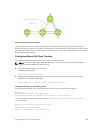
Figure 55. Shared LAG State Tracking
To avoid packet loss, redirect traffic through the next lowest-cost link (R3 to R4). the system has the
ability to bring LAG 2 down if LAG 1 fails, so that traffic can be redirected. This redirection is what is meant
by shared LAG state tracking. To achieve this functionality, you must group LAG 1 and LAG 2 into a single
entity, called a failover group.
Configuring Shared LAG State Tracking
To configure shared LAG state tracking, you configure a failover group.
NOTE: If a LAG interface is part of a redundant pair, you cannot use it as a member of a failover
group created for shared LAG state tracking.
1. Enter port-channel failover group mode.
CONFIGURATION mode
port-channel failover-group
2. Create a failover group and specify the two port-channels that will be members of the group.
CONFIG-PO-FAILOVER-GRP mode
group number port-channel number port-channel number
Examples of Configuring and Viewing LAGs
In the following example, LAGs 1 and 2 have been placed into to the same failover group.
R2#config
R2(conf)#port-channel failover-group
R2(conf-po-failover-grp)#group 1 port-channel 1 port-channel 2
To view the failover group configuration, use the show running-configuration po-failover-
group command.
R2#show running-config po-failover-group
!
port-channel failover-group
group 1 port-channel 1 port-channel 2
Link Aggregation Control Protocol (LACP)
519


















